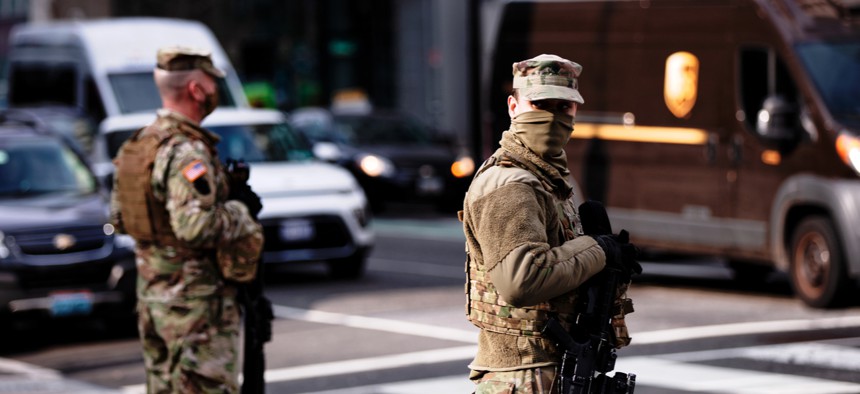Law Enforcement Alert to Potential Violence at Federal Facilities
The Homeland Security Department issued a bulletin on January 27 warning that elected officials and federal facilities could be targets for domestic extremists.
Federal law enforcement personnel are “operating with increased readiness” in the wake of a Homeland Security Department alert warning that elected officials and government facilities are potential targets for violence, a department spokesperson said Thursday evening.
Three weeks after the deadly riots at the U.S. Capitol, the acting Homeland Security secretary issued a bulletin on Wednesday saying that domestic violent extremists “motivated by a range of issues, including anger over COVID-19 restrictions, the 2020 election results, and police use of force have plotted and on occasion carried out attacks against government facilities … DHS is concerned these same drivers to violence will remain through early 2021 and some [domestic violent extremists] may be emboldened by the January 6, 2021, breach of the U.S. Capitol Building in Washington, D.C., to target elected officials and government facilities.”
Asked if the department will be issuing any guidance to federal agencies on how they should protect their workforces and buildings following the bulletin, a spokesperson told Government Executive, “Our DHS law enforcement officers and agents across the country are operating with increased readiness to respond to any threats against our workforce, federal property, or the American public.”
The department’s Federal Protective Service is the “lead agency for federal facility security,” Suzanne Spaulding, senior advisor at the Center for Strategic and International Studies who previously served as DHS under secretary where she led what is now called the Cybersecurity and Infrastructure Security Agency, said, “At times of heightened threat, they convene security officials for all the relevant departments and agencies and ensure that they have all relevant threat information and are taking appropriate steps. In addition, if particular facilities are threatened, FPS officers will augment the contract guards to provide the necessary security presence.”
Depending on what type of facility it is, the Capitol Police or U.S. Marshals Service could also be involved, said Lee Kair, who previously held senior acquisition and security positions at six federal agencies over a 28-year span and now is a principal at The Chertoff Group, a security and risk management advisory firm founded by former Homeland Security Secretary Michael Chertoff, who served under President George W. Bush. The various entities “all have mutual aid agreements with other entities, state and local, that will [provide] aid when it's needed. So what’s important about a bulletin like this is that everyone is very public about what the current situation is.”
As a result, “all of those different entities are going to now be on notice about what the risk is and they’ll be going through their plans” about what actions to take and who to reach out to,” he stated.
Greg Marshall, former chief security officer at Homeland Security, told Government Executive that the department’s risk management report “spells out how the [security] levels are determined,” for each federal faculty so officials can “tell where our vulnerabilities might be, so we can address each facility individually.” The facility’s population, size, threats to tenant agencies, symbolism and mission are the critical factors used to determine the levels.
Kair said that insider threats are also a consideration for law enforcement. At least 31 law enforcement officers across 12 states are under investigation for their behavior or suspected involvement during the U.S. Capitol riots, according to The Associated Press, and 12 National Guard members were removed from Inauguration duty after their background checks raised red flags.
Another challenge, Kair said, is extremists’ shift to using encrypted social media after major platforms, such as Twitter and Facebook removed some inflammatory content. “It’s more difficult now with encrypted point-to-point communication to understand the planning process and where activity may be happening in the future.”
The Office of Management and Budget and General Services Administration declined to comment on guidance about potential threats to federal facilities. An OPM spokesperson referred questions to DHS "as they would be the authority responding to any threats against our workforce, federal property, or the American public.”
Agencies are in a difficult position because they “don't want to signal to any potential bad guys exactly what [they’re] doing to prevent some kind of attack or some kind of threat,” Marshall said.
Kair expressed a similar sentiment. Agencies are “probably trying to provide policy and guidance to their workforce without giving a whole lot of detail about what that policy is, so they can further protect that workforce.”
Following the U.S. Capitol riots, former Homeland Security secretaries from both Democratic and Republican administrations have been repeatedly called on the Senate to quickly confirm Alejandro Mayorkas as the next DHS secretary. The Senate voted on Thursday afternoon to invoke cloture on Mayorkas’s nomination and will take a final vote on Monday evening.
Corri Zoli, associate teaching professor at Syracuse University Law School and director of Research for the university’s Institute for Security Policy and Law said it’s important to send the message that security needs to be a priority for all federal facilities—not just the U.S. Capitol and for members of Congress. “We have plenty of law enforcement tools to consistently prosecute attacks against federal facilities.”
NEXT STORY: How Anthony Fauci Survived Donald Trump








